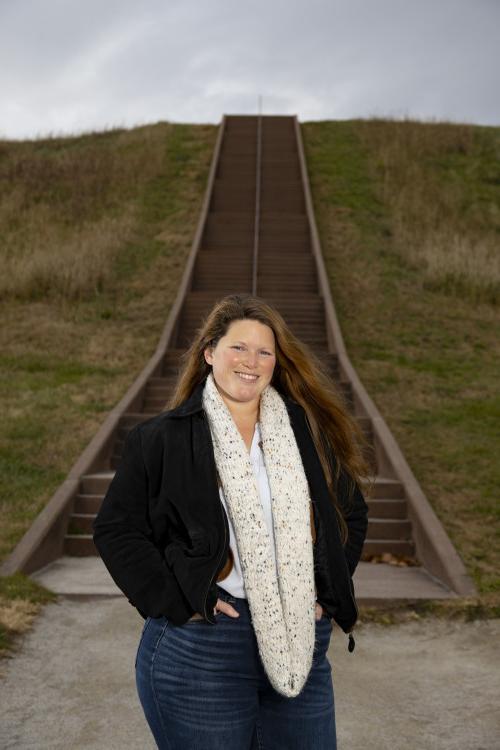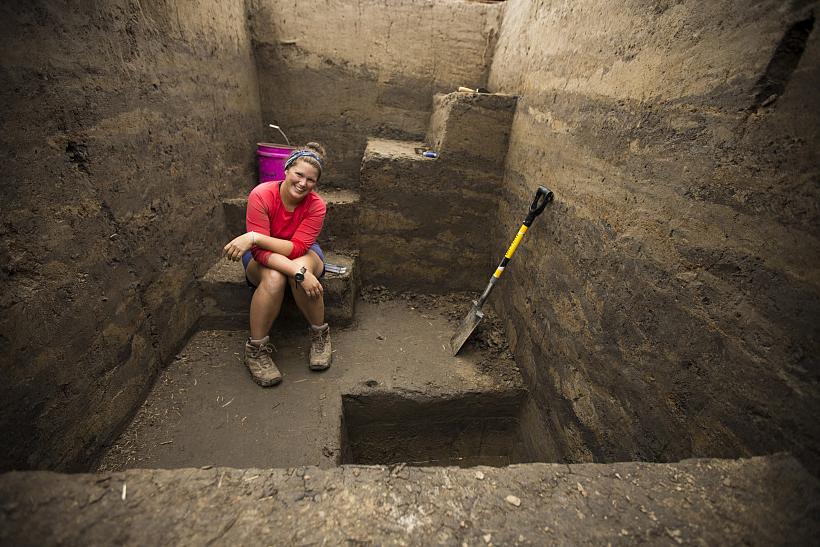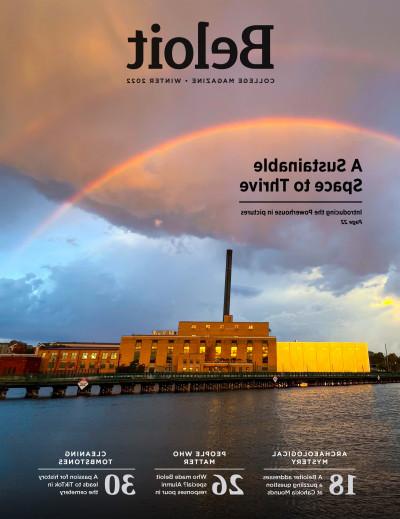核心问题
Geoarchaeologist Caitlin 兰金’14 and her colleagues are untangling this mystery with the latest 太ls, 跨学科思维, and a willingness to challenge long-held assumptions.
到7点.m. 在某些夏日里, foreheads have already started dripping sweat onto researchers’ clipboards at the Cahokia Mounds State Historic Site in southwestern 伊利诺斯州. 一周工作七天是很常见的, and scientists armed with trowels wouldn’t seem 太 paranoid for triple-checking their ankles at the end of a long day for Lyme-carrying ticks.
但是作为回报, sunburned researchers like geoarchaeologist Caitlin 兰金’14, who conducted most of her research at Cahokia as a Ph.D. 华盛顿大学的一名学生. Louis, might be rewarded with a discovery a thousand years in the making.
•••
大约一千年前, a settlement larger than contemporaneous London thrived near what’s now Cahokia, 伊利诺斯州. 在鼎盛时期, the city’s metropolitan area was home to as many as 40,000居民, with four large public plazas acknowledging the four compass directions and dozens of earthen mounds, including a 30-meter platform mound that remained the tallest manmade structure in the United States until 1867.
Such a structure might sound familiar to 贝洛伊特ers, 但不像校园里的土堆, which were constructed by ancestors of the Ho-Chunk people and other tribes, the Cahokia mounds were works of monumental architecture and living spaces as opposed to burial or memorial sites. Both are permanent reminders that all of us are living on Indigenous land.
这些天, Cahokia is regarded by archaeologists as one of North America’s first urban centers, 但在人口达到顶峰400年后, 这个地方几乎被遗弃了. Exactly what happened may be the most obvious question to ask, but it’s also the one that’s kept archaeologists hooked for decades.

图片来源:卡霍基亚土丘国家历史遗址
In 1993, researchers at Southern 伊利诺斯州 University-Edwardsville studied archaeological evidence of increased local wood consumption toward the end of Cahokia’s occupation. They formed a hypothesis that former residents had over-harvested timber from forests nearby, 是什么导致了侵蚀, 最终, 破坏性的洪水. That could mean that Cahokia’s residents were driven out of their homes by careless consumption of their own environment. That hypothesis of self-inflicted ecologic disaster was generally accepted by archaeologists for the better part of 30 years, but the research of Caitlin 兰金’14 has found that the evidence it was built upon was about as stable as an eroded hillside.
重新考虑发生了什么, 兰金 and her team employed a branch of soil science called micromorphology, which investigates the components of soil at a microscopic level. Collaborating with micromorphologists in a German laboratory, they used a technique that treats soil and other unconsolidated sediments like a rock by impregnating them with epoxy so that they’re glued together. They then examined the soil’s microstratigraphy as a geologist might. 使用这种方法, 兰金 was able to spot evidence of Cahokia residents trampling certain paths and even sweeping their earthen floors.
She was also able to check for indications of ancient flooding and erosion. Her team discovered that while flooding did occur in Cahokia, it happened relatively early in the city’s construction and didn’t appear to have deterred human settlement. Erosion and unstable soil do appear in the region’s history, 太, but 兰金’s research didn’t find evidence of them until the mid-19th century—when European colonizers had already begun mining for coal in the area and removing vegetation from nearby bluffs.
These discoveries make way for new hypotheses about what really happened to the Cahokia settlement, including the possibility that it simply ran its course. They also carry implications for less-studied areas of the same site, 和y expose a colonial tendency to “project our own problems, and how we think the world should be” onto societies for which they were not applicable, 兰金最近说.
That impulse to interpret human activity as inherently bad for the environment has created some convenient cautionary tales, but it doesn’t paint an accurate picture of pre-contact people’s understanding of the natural world, or what we can learn from ancient practices on this continent.
“You could easily write a dissertation that confirms a theory that’s already out there, but the kind of work that really makes an impact is the kind that challenges assumptions,比尔·格林这样评价兰金的研究. 绿色 is professor of 人类学 and director emeritus of the Logan Museum of Anthropology and one of 兰金’s mentors while she was an 人类学 student at 贝洛伊特.
“贝洛伊特 was where I learned how to do research,” 兰金 says. “That’s where I was taught how to teach myself … Bill gave me the 太ls and taught me the steps, 然后给了我思考的空间.”
There was never a question that 兰金 would seek an indoors-optional career, forehead sweat and all. 当她2010年来到贝洛伊特时, she was already sure she wanted to study archaeology, 她的眼睛盯着我 经典. 但她在宾夕法尼亚州的一个农场长大, and quickly found that 经典 was a little 太 indoorsy. 几次之后 地质 Sue Swanson教授的课程, 吉姆Rougvie, 和卡尔·门德尔松, “实地考察使我陷入了困境,她说。. She graduated in 2014 with a double major in environmental 地质 and 人类学.
Those two interests neatly accommodate the interdisciplinary field of geoarchaeology, which examines the natural physical processes that impact archaeological sites. It takes an individual who’s accustomed to a liberal arts brand of holistic thinking to enter a field like this one, 格林说:. “Not every geologist understands the human part of what they’re studying, 并不是每个考古学家都了解泥土,他说.
在伯洛伊特攻读学位的时候, 兰金 lived with classmates in the now-defunct Geology House and 太k breaks from 地质 field trips to work in the basement of the Godfrey Anthropology Building as 绿色’s research assistant. Following a summer at the Angel Mounds State Historic Site near Evansville, Ind., through the National Science Foundation’s Research Experiences for Undergraduates program, she decided to head straight to graduate school for 更多的 of the same.
It was difficult to leave 贝洛伊特 behind entirely, however. 在访问华盛顿大学期间. 路易斯,她的导游是69年的约翰·凯利. 绿色, 凯利的老朋友, describes him as a “walking encyclopedia of Cahokia” and one of the site’s most influential scholars. Not long after 兰金 applied, she got a call from Kelly. “那么你想下来吗??他问.
The two 贝洛伊特ers were able to work closely together at Cahokia in the years that followed. “Caitlin was just phenomenal,” Kelly said recently. “我没有牵着她的手什么的. She wasn’t as excited about artifacts as I was, but she was excited about dirt.”
凯利和他的妻子, the archaeologist Lucretia “Cricket” Schryver Kelly’69, met during a 15-week field school in Northern Wisconsin, 在 贝洛伊特计划, the year-round curricular program from their undergraduate years. Comparing and reminiscing about the two different 贝洛伊特s they’d known and loved quickly became a favorite step in their research process.
And that era might not be over for the two of them. Kelly sees an important role for 兰金’s research in an installment of the Oxbow Books series “American Landscapes” that he’s writing about Cahokia with another colleague. 这本书定于明年秋天出版. 就像他最近的很多作品一样, the book will focus on “trying to make sure that American Indians obtain full control over their history, 包括考古学,凯利说。.

图片来源:Dilip Vishwanat兰金, who now works as a research geoarchaeologist for the 伊利诺斯州 State Archaeological Survey through the University of 伊利诺斯州-Urbana/Champaign, is also seeking to remedy what she calls a “lack of collaboration with Indigenous people” in her most recent research. She is working with a variety of tribes 和 Missouri Department of Conservation to help grow native plants using Indigenous agricultural strategies.
Meanwhile, her paradigm-shifting findings, which make up one part of her Ph.D. 论文,正在引起全国的关注. 在2020年5月获得博士学位后, she published her work with two other researchers in the journal 地质考古学 in February 2021, and it was picked up by outlets like 国家地理, 全国公共广播电台, 史密森尼杂志 和 纽约时报.
There’s excitement about her discoveries because of the technology her team utilized, which didn’t exist when the Southern 伊利诺斯州 University-Edwardsville researchers published their own hypothesis, but also because many in the scientific community are eager for opportunities to re-examine their own fields’ chronically colonial thinking. 兰金 says it’s a step in the right direction that we are “recognizing these assumptions in the first place.”
兰金 repurposes a beloved 贝洛伊特 phrase when she speaks about the importance of interdisciplinary education in her life and career. 给她, 想象大海里满是漂浮的海龟, each bearing invaluable knowledge but unable to communicate with one another, illustrates when disciplines like 人类学 and 地质 don’t collaborate. Then she pictures the turtles stacked on top of each other, passing knowledge up and down and enriching one another’s understanding of the world.
The future of scientific research, 兰金 says, is “turtles all the way down.”
Clare Eigenbrode’20 is a writer currently working for an AmeriCorps program called City Year Milwaukee.





